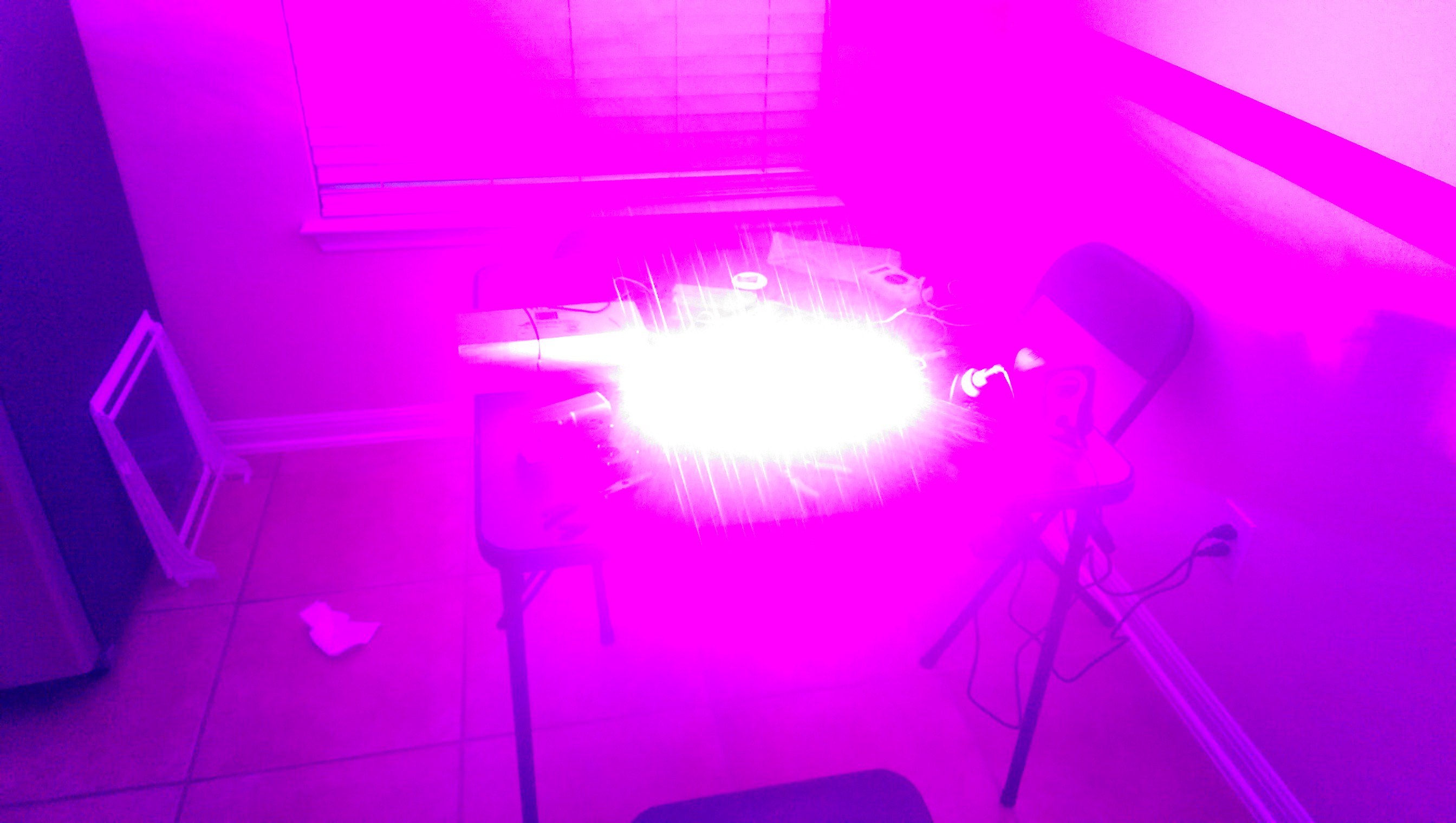-
The mystery of the 3 Watt LED's
08/21/2014 at 04:42 • 0 commentsSo, If you have been reading my other project logs you may have noticed that my LED grow light uses thirty 3 watt LED's. But that I am using two 36 watt power supplies. And honestly I am confused also about this... What I know for sure is that none of the "3 watt" LED's that I have actually pull three watts of power.
I have two different types of LED's on the grow light. 450nm Blue LED's and 660nm Red LED's. The power draw for each type of LED can be calculated easily using the following formula.P = V * A
So Power is equal to Voltage times Current. I took a volt meter to measure the voltage drop across each type of LED and here is what I found.
450nm LED Voltage drop = 3.74 Volts660nm LED Voltage drop = 2.60 Volts
Since the LED's are connected to a constant current power supply outputting 700mA of current it simple to compute the power. So using the formula above...
450nm LED power = 3.74 Volts * 0.7 A = 2.618 Watts
660nm LED power = 2.60 Volts * 0.7 A = 1.82 Watts
In the case of the 450nm LED's they are close to 3 watts. But the 660nm Red LED's are using almost 1/2 of the "Rated" 3 watts. Looking at other "3 Watt" LED's they all have similar current and voltage usage. So I am not really sure why they call them "3 Watt" LED's... But in any case, my LED grow light has 62 Watt's of LED's which I feel should be enough for plants I plan to grow. -
Before First Light part 2
08/20/2014 at 05:05 • 0 commentsI was interrupted trying to catch a flight while working on the last project log. So continuing...
I also found that 3 Watt 660nm(Red) LED's were slightly less costly at about $.90 each. So the LED's were within reach from a cost stand-point. The question became how many and how to power the LED's. Searching online I found that MeanWell offers a line of IP-67(fully waterproof) constant current power supplies. I found of pair of the 36 Watt MeanWell supplies on Ebay for $19 each.
With 72 Watt's of LED's I needed some way to dissipate the heat that the LED's would generate and some way of mounting the LED's. I decided that I could fill both requirements by using a large heatsink as mounting for the LED's. By using Thermal epoxy I didn't have to drill into the heatsink to mount the LED's.
So the home made LED Grow light is two 36 Watt power supplies each driving ten 3 Watt 660nm (Red) LED's and five 3 Watt 450nm (Blue) LED's. Giving me a total of 30 LED's being driven by a two constant current 700mA power supplies. Mounted to a large heatsink. -
Before First Light
08/05/2014 at 08:07 • 0 commentsWell, this is a project log intended to give people an idea how to where I am with the project at this point.
I am sure I can trace the idea of this project back to a trip to Epcot Center when I was 7 years old. The "Land" exhibit featured airoponics and hydroponics with some aquaculture in addition. It was a very memorial visit. Many years later(around 2005), I saw information about NASA exploring the idea of using LED Lights and airoponics to feed people on the ISS.
This really got me interested in doing this at home. The first investigations into using LED's had me quickly finding that I could only afford systems that would use only 3-6 watts of LED's. In 2005 I could only find 1/4 watt LED's to create a LED light. In the end, I wasn't sure 3 watts's would be enough. So I put the whole idea on hold. In 2009 I looked again. This time, 1 watt LED's had fallen to about $8 each. The idea was within reach if I built a 9 watt system. But after finding some people that had tried LED systems, it was clear that 9 watts just wouldn't be enough.
Then finally late last year, I looked again. At the time, the blue 450nm LED were down to about $1 each for a 3 Watt LED. -
First Light
07/27/2014 at 04:18 • 0 commentsWell, this week was the week that I finally got started on this project. After months of delaying this project I finally wired up the LED drivers and mounted the LED's on the heatsink. I used thermal epoxy to attach the Led's to the heatsink. But I learned a few rather important things.
![]()
The biggest surprise is that the heatsink is not large enough to fully passively cool the LED's over a long amount of time. So I am going to have to add a fan to cool the LED's.
Since this is the first log and I have been working on and off with this project for the last few months I am going to have to write another log to explain how I got here. But for now... Led's wired up and working in total 64 watts of power(at the LED's).
Web Connected Hydroponic Led Grow System
A Homemade LED Grow light and hydroponic system connected to a Spark Core for web control and monitoring.
